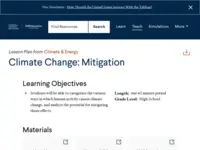https://education.cfr.org/teach/lesson-plan/climate-change-mitigation
Council of Foreign Relations
This learning activity takes one 45 minute class period.
Learn more about Teaching Climate Literacy and Energy Awareness»Grade Level
Online Readiness
Climate Literacy
This Activity builds on the following concepts of Climate Literacy.
Click a topic below for supporting information, teaching ideas, and sample activities.
Energy Literacy
This Activity builds on the following concepts of Energy Literacy.
Click a topic below for supporting information, teaching ideas, and sample activities.
Notes From Our Reviewers
The CLEAN collection is hand-picked and rigorously reviewed for scientific accuracy and classroom effectiveness.
Read what our review team had to say about this resource below or learn more about
how CLEAN reviews teaching materials
Teaching Tips | Science | Pedagogy |
Technical Details
Teaching Tips
- The teaching guide identifies a short article that should be read as homework about the different sectors of GHG emissions. It would be good to summarize those again at the start of class. Or have a collaborative (online) board for students to work on as part of their homework about the different sectors.
- With more time, educators could have students research nearby local sources of the pollutants based on the sector their group is assigned. Then they could make a poster about their topic with the information in the graphic organizers and add in information about the local polluter. Then, when they make a letter to their congressperson they can reference the local emitter that should be better regulated.
- Students who are English language learners or slow readers might need a little extra support. There is not a lot of scaffolding, but it is good that the students break up into groups and then they can work together on understanding the reading and making their summaries about the different pollution sectors.
About the Content
- The articles in this activity present current scientific content about greenhouse gases, sources of emissions, and mitigation actions.
- The lesson presents real data, visualized in easy-to-understand graphics, with links to credible sources. Data is available for download and the background materials are written in an accessible style.
- The information is highly credible. Links to actual data are provided, as well as citations to the agencies that provided the data.
- One of the questions in the handout focuses on government actions, and this emphasis may lead to a misconception that only the government can take effective action on climate change. Educators could address this by emphasizing that businesses, nonprofit organizations, and individuals can also play important roles.
- The activity is not highly rigorous in that it does not explicitly call for comparing mitigation methods quantitatively and it does not involve manipulating data.
- Passed initial science review - expert science review pending.
About the Pedagogy
- In this activity, students read articles, answer questions in a handout, then write a letter to their congressional representative as homework. The activities are done partly as individuals and partly in groups and as a whole class.
- The activity lends itself to students being able to meet the first part of the learning objective, which is to categorize various ways in which human activity causes climate change. The second part is meant to be done as a jigsaw activity/group work, which may help as the students can break up the work.
- The information is presented in a way that is easy to read and visually appealing, with clear graphics. The teacher's guide is well organized and concise, with there being a provided vocabulary list, which may be helpful.
- The jigsaw activity is a great way to keep more students engaged and the lesson is relatively short, so it should be able to hold attention.
- The handout questions engage students in thinking about their own communities.
- This resource engages students in using scientific data.
See other data-rich activities
Technical Details/Ease of Use
- The activity requires a computer or tablet and an internet connection, and there are no additional costs. The data are easily accessible because they can be viewed on the screen and also downloaded. The external links work well.
- The activity is well organized and generally highly usable, as it is a simple activity. A teacher would want to spend some time reading the content in advance to guide discussion, but the readings are not long. Teachers should plan for about 10-15 minutes of preparation time.








